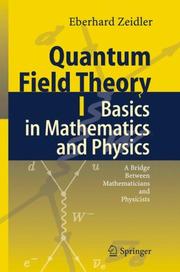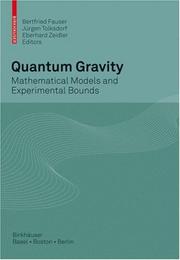| Listing 1 - 5 of 5 |
Sort by
|

ISBN: 128085328X 9786610853281 354034764X 3540347623 Year: 2006 Publisher: Berlin ; New York : Springer,
Abstract | Keywords | Export | Availability | Bookmark
 Loading...
Loading...Choose an application
- Reference Manager
- EndNote
- RefWorks (Direct export to RefWorks)
This is the first volume of a modern introduction to quantum field theory which addresses both mathematicians and physicists ranging from advanced undergraduate students to professional scientists. The book tries to bridge the existing gap between the different languages used by mathematicians and physicists. For students of mathematics it is shown that detailed knowledge of the physical background helps to motivate the mathematical subjects and to discover interesting interrelationships between quite different mathematical topics. For students of physics, fairly advanced mathematics is presented, which is beyond the usual curriculum in physics. It is the author's goal to present the state of the art of realizing Einstein's dream of a unified theory for the four fundamental forces in the universe (gravitational, electromagnetic, strong, and weak interaction). From the reviews: "… Quantum field theory is one of the great intellectual edifices in the history of human thought. … This volume differs from other books on quantum field theory in its greater emphasis on the interaction of physics with mathematics. … an impressive work of scholarship." (William G. Faris, SIAM Review, Vol. 50 (2), 2008) "… it is a fun book for practicing quantum field theorists to browse, and it may be similarly enjoyed by mathematical colleagues. Its ultimate value may lie in encouraging students to enter this challenging interdisciplinary area of mathematics and physics. Summing Up: Recommended. Upper-division undergraduates through faculty." (M. C. Ogilvie, CHOICE, Vol. 44 (9), May, 2007).
Quantum field theory. --- Field theory (Physics) --- Relativistic quantum field theory --- Quantum theory --- Relativity (Physics) --- Classical field theory --- Continuum physics --- Physics --- Continuum mechanics --- Global analysis (Mathematics). --- Quantum theory. --- Mathematical physics. --- Functional analysis. --- Differential equations, partial. --- Theoretical, Mathematical and Computational Physics. --- Analysis. --- Elementary Particles, Quantum Field Theory. --- Mathematical Methods in Physics. --- Functional Analysis. --- Partial Differential Equations. --- Partial differential equations --- Functional calculus --- Calculus of variations --- Functional equations --- Integral equations --- Physical mathematics --- Quantum dynamics --- Quantum mechanics --- Quantum physics --- Mechanics --- Thermodynamics --- Analysis, Global (Mathematics) --- Differential topology --- Functions of complex variables --- Geometry, Algebraic --- Mathematics --- Mathematical analysis. --- Analysis (Mathematics). --- Elementary particles (Physics). --- Physics. --- Partial differential equations. --- Natural philosophy --- Philosophy, Natural --- Physical sciences --- Dynamics --- Elementary particles (Physics) --- High energy physics --- Nuclear particles --- Nucleons --- Nuclear physics --- 517.1 Mathematical analysis --- Mathematical analysis
Book
ISBN: 3540853766 9786611772987 1281772984 3540853774 Year: 2009 Publisher: Berlin : Springer,
Abstract | Keywords | Export | Availability | Bookmark
 Loading...
Loading...Choose an application
- Reference Manager
- EndNote
- RefWorks (Direct export to RefWorks)
This is the second volume of a modern introduction to quantum field theory which addresses both mathematicians and physicists ranging from advanced undergraduate students to professional scientists. This book seeks to bridge the existing gap between the different languages used by mathematicians and physicists. For students of mathematics it is shown that detailed knowledge of the physical background helps to discover interesting interrelationships between quite diverse mathematical topics. For students of physics fairly advanced mathematics, beyond that included in the usual curriculum in physics, is presented. The present volume concerns a detailed study of the mathematical and physical aspects of the quantum theory of light.
Condensed matter. --- Mathematical physics. --- Quantum field theory. --- Mathematics --- Physics --- Physical Sciences & Mathematics --- Calculus --- Electricity & Magnetism --- Quantum electrodynamics. --- Relativistic quantum field theory --- Electrodynamics, Quantum --- QED (Physics) --- Mathematics. --- Mathematical analysis. --- Analysis (Mathematics). --- Functional analysis. --- Partial differential equations. --- Geometry. --- Physics. --- Analysis. --- Partial Differential Equations. --- Mathematical Methods in Physics. --- Theoretical, Mathematical and Computational Physics. --- Functional Analysis. --- Field theory (Physics) --- Quantum theory --- Relativity (Physics) --- Quantum field theory --- Schwinger action principle --- Global analysis (Mathematics). --- Differential equations, partial. --- Partial differential equations --- Analysis, Global (Mathematics) --- Differential topology --- Functions of complex variables --- Geometry, Algebraic --- Euclid's Elements --- Functional calculus --- Calculus of variations --- Functional equations --- Integral equations --- Physical mathematics --- Natural philosophy --- Philosophy, Natural --- Physical sciences --- Dynamics --- 517.1 Mathematical analysis --- Mathematical analysis

ISBN: 1281343366 9786611343361 3764379782 3764379774 Year: 2007 Publisher: Basel ; Boston : Birkhauser,
Abstract | Keywords | Export | Availability | Bookmark
 Loading...
Loading...Choose an application
- Reference Manager
- EndNote
- RefWorks (Direct export to RefWorks)
The construction of a quantum theory of gravity is the most fundamental challenge confronting contemporary theoretical physics. The different physical ideas which evolved while developing a theory of quantum gravity require highly advanced mathematical methods. This book presents different mathematical approaches to formulate a theory of quantum gravity. It represents a carefully selected cross-section of lively discussions about the issue of quantum gravity which took place at the second workshop "Mathematical and Physical Aspects of Quantum Gravity" in Blaubeuren, Germany. This collection covers in a unique way aspects of various competing approaches. A unique feature of the book is the presentation of different approaches to quantum gravity making comparison feasible. This feature is supported by an extensive index. The book is mainly addressed to mathematicians and physicists who are interested in questions related to mathematical physics. It allows the reader to obtain a broad and up-to-date overview on a fascinating active research area. .
Quantum gravity --- Mathematical models --- Gravity, Quantum --- General relativity (Physics) --- Gravitation --- Quantum theory --- Quantum theory. --- Mathematical physics. --- Mathematics. --- Astronomy. --- Classical and Quantum Gravitation, Relativity Theory. --- Elementary Particles, Quantum Field Theory. --- Mathematical Methods in Physics. --- Applications of Mathematics. --- Quantum Physics. --- Astronomy, Astrophysics and Cosmology. --- Math --- Science --- Physical mathematics --- Physics --- Quantum dynamics --- Quantum mechanics --- Quantum physics --- Mechanics --- Thermodynamics --- Mathematics --- Gravitation. --- Elementary particles (Physics). --- Quantum field theory. --- Physics. --- Applied mathematics. --- Engineering mathematics. --- Quantum physics. --- Astrophysics. --- Astronomical physics --- Astronomy --- Cosmic physics --- Engineering --- Engineering analysis --- Mathematical analysis --- Natural philosophy --- Philosophy, Natural --- Physical sciences --- Dynamics --- Relativistic quantum field theory --- Field theory (Physics) --- Relativity (Physics) --- Elementary particles (Physics) --- High energy physics --- Nuclear particles --- Nucleons --- Nuclear physics --- Matter --- Antigravity --- Centrifugal force --- Properties
Book
ISBN: 3764387351 9786612364877 1282364871 376438736X Year: 2009 Publisher: Basel : London : Birkhauser ; Springer [distributor],
Abstract | Keywords | Export | Availability | Bookmark
 Loading...
Loading...Choose an application
- Reference Manager
- EndNote
- RefWorks (Direct export to RefWorks)
For more than 70 years, quantum field theory (QFT) can be seen as a driving force in the development of theoretical physics. Equally fascinating is the fruitful impact which QFT had in rather remote areas of mathematics. The present book features some of the different approaches, different physically viewpoints and techniques used to make the notion of quantum field theory more precise. For example, the present book contains a discussion including general considerations, stochastic methods, deformation theory and the holographic AdS/CFT correspondence. It also contains a discussion of more recent developments like the use of category theory and topos theoretic methods to describe QFT. The present volume emerged from the 3rd 'Blaubeuren Workshop: Recent Developments in Quantum Field Theory', held in July 2007 at the Max Planck Institute of Mathematics in the Sciences in Leipzig/Germany. All of the contributions are committed to the idea of this workshop series: 'To bring together outstanding experts working in the field of mathematics and physics to discuss in an open atmosphere the fundamental questions at the frontier of theoretical physics'.
Quantum field theory. --- Quantum field theory --- Atomic Physics --- Physics --- Physical Sciences & Mathematics --- Mathematical physics. --- Physical mathematics --- Relativistic quantum field theory --- Mathematics --- Physics. --- Quantum physics. --- Quantum Physics. --- Mathematical Methods in Physics. --- Field theory (Physics) --- Quantum theory --- Relativity (Physics) --- Quantum theory. --- Quantum dynamics --- Quantum mechanics --- Quantum physics --- Mechanics --- Thermodynamics --- Natural philosophy --- Philosophy, Natural --- Physical sciences --- Dynamics
Book

Year: 2019 Publisher: Basel : Birkhäuser,
Abstract | Keywords | Export | Availability | Bookmark
 Loading...
Loading...Choose an application
- Reference Manager
- EndNote
- RefWorks (Direct export to RefWorks)
Die wichtigsten Texte zu OMA / Rem Koolhaas The activities of Rem Koolhaas and his staff were widely discussed even before the foundation of the Office for Metropolitan Architecture in 1975. Today, many contributions on the work of OMA can be found in the international architectural press, including Koolhaas' own writings. The book contains about 150 selected texts-interviews, feature articles, essays, lead articles, reviews, letters, introductions, appraisals, and competition reports that have been compiled for the first time. This compilation not only provides a fresh and critical view of the oeuvre of one the most important contemporary architects, but also represents an account of the debate on architectural and urban design in recent decades.
| Listing 1 - 5 of 5 |
Sort by
|

 Search
Search Feedback
Feedback About UniCat
About UniCat  Help
Help News
News